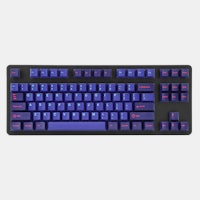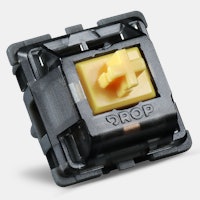Click to view our Accessibility Statement or contact us with accessibility-related questions
















Support for Alternative Layouts

search
close
Sort by: Newest
keyboard_arrow_down
purple_rw
61
Jun 25, 2024
I have always wondered what that homing A keycap is for...... I also prefer having correct legends on the keycaps than blanks. One of the major reasons I picked Colemak DH when switching from Qwerty ~5 years ago was the lack of keycap support for other seemingly better layouts.
So far, I only buy keycap sets that support Colemak DH (except for one set that is for my wife). It seems there are less keycap GB in the past year or 2 that include Colevrak set. With so many new layouts, I worry that everyone would just go for blanks, and even uniform profile keycap set would be hard to find!
JohnnyFlack
8
May 25, 2024
I would love a layout that utilizes the widened mod but splits the middle with blockers like an alice split.

zixdrop
1
May 24, 2024
Interested to know about the ortho keyboard in the top pic. What is that? Pretty please.

dvorcol
5404
Keyboard Club Member
Jun 25, 2024
Glad you like it! I agree the mis-aligned 2.25u Enter is not ideal, but I did it so novelty Enters always worked. Just curious, where have you seen 2.5u keycaps for any row? I don't think I ever have, not even as spacebars.
Using 1.5u mods didn't work out very well. My plan was to get them from Ergodox kits. I knew it'd be pricey, but they were common at the time. Ergodox kits are rare now, so I've resigned myself to using 1.5u from other rows.
I'm thinking my next full ortho board will only use the standard-size keycaps found in Base kits.

purple_rw
61
Jun 26, 2024
dvorcolI haven't been paying much attention to >1u keycaps as almost all my boards use 1u keycap only. You might be right that there is no 2.5u for any row!
Using keycaps from Base kit could be good. The board would probably cost less. But most likely you won't get the keys to align on either side of the alpha section. More difficult to design it to look tidy and clean. Post some pics when you have your new board!

psxndc
214
May 23, 2024
GREAT to see this article by you. You made my go-to chart for Colevrak+ support years ago, so it's nice to see you writing articles for Drop.
I personally use a modified version of Colemak-DHm. I've moved the quote key up to R2 pinky finger and leave semicolon down in the R3. And of course, I use only ortho keyboards. :)
Would be great to see more support for Colevrak+ in Drop's keycap offerings.
(Edited)

dovenyi
78
May 2, 2024
This was an excellent read even for a touch typer who doesn't really bother with keycap compatibility while using custom layouts.

purple_rw
61
Jun 25, 2024
I have a 2x4 macropad loaded with a layout using combos for one-hand input, inspired by Artsey. I have thought of incorporating the whole thing into a layer (or layers) on my main keyboard, but haven't got the time.

dvorcol
5404
Keyboard Club Member
Jun 25, 2024
purple_rwWow, that's very interesting. It reminds me of stenography. I have a hard time holding my ring finger up while using the other three, and I'm a lousy piano player. But I might give it a try just for fun.
PRODUCTS YOU MAY LIKE
Trending Posts in Mechanical Keyboards
The-Cindy
This is easily my new favorite keeb
The IDOBAO ID80 Crystal Gasket Keyboard Kit is a standout choice for mechanical keyboard enthusiasts seeking both aesthetics and performance. Its transparent acrylic case beautifully showcases the...
Dec 20, 2024
Squizzle
Keyboard & Drink
Shine-Through LOTR Keycaps Concept
Would anyone else be interested in a shine-through set of LOTR keycaps? Imagine a glowing black speech keycap set that seduces like the one ring. Perhaps the pale blue moonlight glow of the elven...
Dec 20, 2024
Akofena
Are shipments to Argentina safe?
I want to buy a keyboard with some keycaps ! but i live in argentina. ty
Dec 17, 2024

tbui
Absolutely stunning
The colors really pop on a white board. Easily one of the best caps I own!
Dec 17, 2024
bobbibeer1976
False Advertising BEWARE
This company should be ashamed of themselves. Advertising to young people who save all their money and want nothing more than a keyboard and advertise to them that it is in stock and will be shipped asap and they will arrive before Christmas. Only to "ship" and package and get their hopes up and it arrives and there is no keyboard in the package. Then to get on the website and it isn't even going to ship until January. This happens AFTER you have received their money and made promises that it was arriving, on it 's way, etc! Shame Shame on you!!!
Dec 16, 2024

EuclideanGambit
Closest profile to MT3
I really enjoy the MT3 profile, it has actually become kind of difficult to type on other profiles. So I was looking for some that might be close and noticed the SA profile. I was wondering if there were anymore that were close to it. This would open my options significantly when shopping around.
Dec 15, 2024

tbui
Displaying my DCD Lunar New Year set (Max)
Enough for a full base kit plus novelties, just gotta watch the ample space on top when moving/tilting and near the edges it gets tight so the caps don't fit in as smoothly.
Dec 15, 2024














The expansion The Workman layout was introduced in 2010, Norman about three years later, and then the DH revision of Colemak in 2014. Keycaps were added to support more layouts, and various kit names were used to reflect the increased coverage. Let's use Colevrak+ here. The kit render below illustrates why various keycaps were added. Additional support did not necessarily follow the order listed here.
Wide mod is not a unique layout, but rather a modification intended to improve ergonomics by increasing the gap between hands. I've shown it first because it works for all alt layouts mentioned above, with the exception of Dvorak. It can even be used on QWERTY. Only two unique keycaps are needed, one of which is already included for Dvorak.
ColemaQ is Nyfee’s rearrangement of Colemak DH.
Workman was introduced by OJ Bucao in 2010.
Niro was introduced by kessentchaz in 2021. It uses Workman’s R2 D.
Norman was introduced by David Norman in 2013.
QWPR was introduced by chema_quinn in 2013. It uses Norman’s R2 K.
QGMLWY was introduced by Martin Krzywinski in 2010. It requires the addition of R2 M and homing A.
Programmer Dvorak was developed between 1997 and 2012 by Roland Kaufmann (see here and here). While it uses 19 keycaps from standard Dvorak and one from Colemak, TKL support requires an additional 15 unique keycaps: R2 at/caret, R4 apostrophe/quote, and 13 R1 keycaps with unique legends. Occasionally Colevrak+ has included just one of these keycaps – R4 apostrophe/quote – for partial support. An additional 6 unique keycaps are needed to cover the numpad: R2 is 1/2/3 and R4 is 7/8/9 to match the telephone layout.
Sculpted-profile summary table The table below highlights the keycaps needed by each of the eleven alt layouts mentioned above.
Eight-finger homing coverage is shown in honor of sets that included QWERTY eight-finger homing kits. Four examples are SA Jukebox's Deep Dish Homing Row, MT3 Serika r1's Super Homing, MT3 Serika r2's Geometries & Novelties, and MT3 Extended 2048’s Homing Addon. These were probably inspired by the home row of the Realforce HiPro keyboard. The eight-finger kit will also satisfy those who prefer middle finger homing, which was not uncommon before the turn of the century. Take early Apple keyboards, for example. (photo curtesy mr_a500)